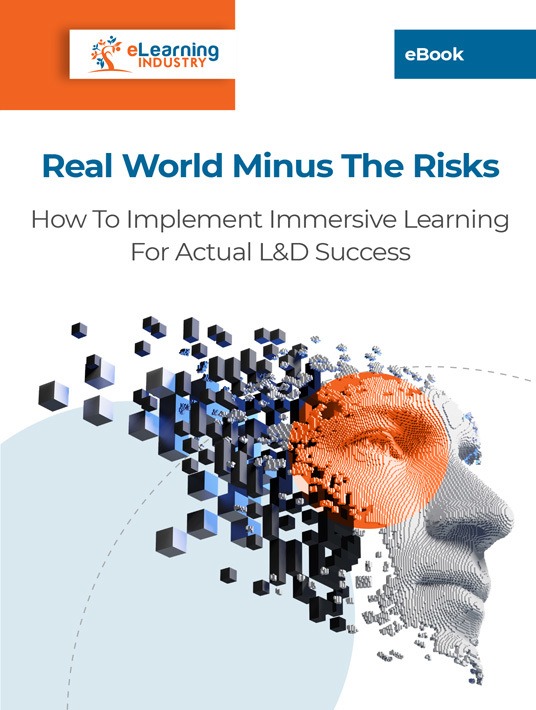Create Successful Interactive eLearning Activities
What is immersive learning? At its core, immersion is all about facilitating real-world application and encouraging employees to evaluate their own behaviors. VR and AR are part of the process, but not the only way to facilitate immersive learning experiences. Even telling a story or viewing a demo video on the go can engage your remote workforce. That said, Mixed Reality does help eliminate external distractions and bring them into the right frame of mind. Employees are able to interact with objects, sink into practical scenarios, and reflect on their performance. What does it take to achieve this level of immersion? Successful interactive online training activities that include these 7 crucial elements.

1. Real-World Challenges
The main purpose of immersive learning is to determine how employees react in practical situations. How they handle a difficult co-worker who feels the need to disagree with everyone. Or how to find the ideal product for a customer based on their needs and pain points. As such, successful interactive online training environments involve real-world challenges that are relatable for every member of the team. In other words, everyone should be able to find meaning in the online training experience and apply what they’ve learned in a contextual setting.
2. Multisensory Elements
Complete immersion involves multisensory elements that allow employees to connect and eliminate external distractions ranging from engaging visuals to realistic background audio. The goal is to encourage them to step inside the Virtual Training Environment, figuratively speaking, and focus on the task in front of them. Even if it’s watching a product demo video and soaking up all the crucial info about the features and specs. This way, employee training participants lose themselves in the activity and overcome the negative preconceptions that limit their potential.
3. Personalized Learning
First and foremost, immersive learning is personalized. I’m not suggesting that you develop a separate online training library for every staffer. However, everyone should be able to glean something from interactive eLearning activities. Whether it’s to identify a skill gap or test their response to a challenging customer. The beautiful thing about immersive online training is that employees can approach the situation or problem from their perspective. For example, their backgrounds and niche expertise dictate how they handle the COI simulation. It’s a more holistic online training experience that’s adaptable and individualized based on the employee training participants' cognition. They can also discuss the interactive eLearning activity in social media groups and forums to broaden their understanding of the topic. For instance, how did they react to the irate customer and what could they do differently?
4. Encouraging Experimentation
Employees should have the chance to test out different approaches and see where they take them. They can experiment and discover the real-world outcomes of their actions or behaviors, rather than having to disclose them in the workplace where mistakes often have a ripple effect on the entire company. Effective immersive learning environments encourage risk-taking. Calculated risks that help employees identify their flaws and hidden talents. That said, the interactive eLearning activity should also help them organize their thoughts and map out strategies to mitigate those risks.
5. Built-In eLearning Feedback
Some immersive online training resources provide direct eLearning feedback in the form of performance overviews or follow-up recommendations. However, for the most part, eLearning feedback should be embedded in the activity. For example, an employee chooses the incorrect path or misses a task step. This leads to immediate consequences that show them where they went wrong and how to improve the situation. They experience the eLearning feedback firsthand in the Virtual Training Environment instead of being told what to do or how to bridge gaps. It’s a self-guided process that involves personal evaluation and assessment. They can only achieve the best outcome if they implement all the steps and skills they’ve learned in online training.
6. Focusing On Contextual Skills Application
Applying skills in a practical setting is one of the most challenging aspects of online training design. How do you get your employees to put their talents into practice and turn learned behaviors into habits? Immersive learning environments should concentrate on contextual skills application such as how to use their communication skills to help customers or build a stronger team. Then they can explore different applications on their own once they’ve mastered the behaviors. For instance, they can use those same active listening and nonverbal communication skills to mentor a coworker. The VR and AR online training resources are simply a starting point to facilitate knowledge transfer and move from theory to practice.
7. Eliminating External And Internal Distractions
It’s relatively easy to remove the external distractions from your online training activities when VR headsets are involved. Employees slip them on and find themselves in the middle of a virtual task or challenge. However, your interactive eLearning activities must also eliminate internal distractions. Wandering minds and stressors that prevent employees from engaging with the online training content and achieving mental focus. For example, start the simulation or game with a brief overview of the task so that employees know what to concentrate on. Then give them a moment to reflect on their work performance before diving into the activity. This allows employee training participants to shift their focus and emotionally invest in the online training experience.
These immersive learning fundamentals help break down the mental barriers so that employees can focus on the task, instead of letting work-related stress and busy office environments get in the way. They also make online training content more relatable and relevant, which enables employee training participants to connect on a personal level. The goal of VR and AR training is to immerse employees in the moment. To give them the opportunity to face challenges, overcome them, and reflect on the online training experience.
A Mixed Reality training strategy doesn’t have to drain your organization’s resources or make you go over budget. Download the eBook Real World Minus The Risks: How To Implement Immersive Learning For Actual L&D Success, and discover how you can benefit from incorporating immersive learning into your online training program. Provide an engaging training experience and boost your employees’ confidence with a Mixed Reality training solution.

